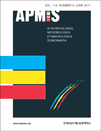Differential patterns of spinal cord pathology induced by MP4, MOG peptide 35–55, and PLP peptide 178–191 in C57BL/6 mice
Abstract
Kuerten S, Gruppe TL, Laurentius L-M, Kirch C, Tary-Lehmann M, Lehmann PV, Addicks K. Differential patterns of spinal cord pathology induced by MP4, MOG peptide 35–55 and PLP peptide 178–191 in C57BL/6 mice. APMIS 2011; 119: 336–46.
In this study we demonstrate that experimental autoimmune encephalomyelitis (EAE) induced by the MBP–PLP fusion protein MP4, MOG peptide 35–55, or PLP peptide 178–191 in C57BL/6 mice, respectively, displays distinct features of CNS pathology. Major differences between the three models resided in (i) the region-/tract-specificity and disseminated nature of spinal cord degeneration, (ii) the extent and kinetics of demyelination, and (iii) the involvement of motoneurons in the disease. In contrast, axonal damage was present in all models and to a similar extent, proposing this feature as a possible morphological correlate for the comparable chronic clinical course of the disease induced by the three antigens. The data suggest that the antigen targeted in autoimmune encephalomyelitis is crucial to the induction of differential histopathological disease manifestations. The use of MP4-, MOG:35–55-, and PLP:178–191-induced EAE on the C57BL/6 background can be a valuable tool when it comes to reproducing and studying the structural–morphological diversity of multiple sclerosis.




